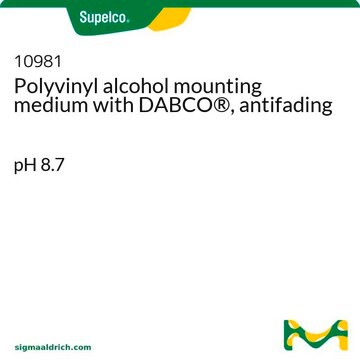8.03456
1,4-Diazabicyclo[2.2.2]octane
for synthesis
Synonyme(s) :
1,4-Diazabicyclo[2.2.2]octane, Triethylenediamine, DABCO
About This Item
Produits recommandés
Pression de vapeur
0.68 hPa ( 21 °C)
Niveau de qualité
Pureté
≥98.0% (GC)
Forme
solid
Température d'inflammation spontanée
350 °C
Puissance
700 mg/kg LD50, oral (Rat)
Caractéristiques du produit alternatif plus écologique
Catalysis
Learn more about the Principles of Green Chemistry.
sustainability
Greener Alternative Product
Point d'ébullition
173.4 °C/1000 hPa
Pf
155-158 °C
Température de transition
flash point 62.2 °C
Solubilité
400 g/L
Densité
1.14 g/cm3 at 25 °C
Masse volumique apparente
800 kg/m3
Autre catégorie plus écologique
Température de stockage
2-30°C
InChI
1S/C6H12N2/c1-2-8-5-3-7(1)4-6-8/h1-6H2
Clé InChI
IMNIMPAHZVJRPE-UHFFFAOYSA-N
Catégories apparentées
Description générale
Application
- Biocompatible Polymer Composites: Research demonstrates the development of a reactive compatibilization method using 1,4-diazabicyclo[2.2.2]octane as a catalyst for the preparation of polylactic acid/poly(butylene adipate-co-terephthalate)/thermoplastic starch ternary bio-composites. This approach significantly improves the mechanical and biodegradable properties of the composites, suitable for environmentally friendly applications in the packaging and automotive industries (Fang et al., 2024).
- Cobalt Single-Atom Catalysts: Research on the development of cobalt single-atom catalysts encapsulated in a metal-organic framework using 1,4-diazabicyclo[2.2.2]octane. This catalyst shows exceptional efficiency in the oxygen reduction reaction, important for energy conversion technologies such as fuel cells and metal-air batteries (Gao et al., 2024).
- Advanced Analytical Techniques: Study on the use of 1,4-diazabicyclo[2.2.2]octane in advanced derivatization techniques for the analysis of Novichok agents in biofluids using LC-MS. This research contributes to the field of forensic science and chemical warfare agent detection, providing robust methods for emergency responses and public safety (Yamaguchi et al., 2023).
Remarque sur l'analyse
Water (K. F.): ≤ 1.0 %
Identity (IR): passes test
Mention d'avertissement
Danger
Mentions de danger
Conseils de prudence
Classification des risques
Acute Tox. 4 Oral - Eye Dam. 1 - Flam. Sol. 1 - Skin Irrit. 2
Code de la classe de stockage
4.1B - Flammable solid hazardous materials
Classe de danger pour l'eau (WGK)
WGK 1
Point d'éclair (°F)
144.0 °F - closed cup
Point d'éclair (°C)
62.2 °C - closed cup
Certificats d'analyse (COA)
Recherchez un Certificats d'analyse (COA) en saisissant le numéro de lot du produit. Les numéros de lot figurent sur l'étiquette du produit après les mots "Lot" ou "Batch".
Déjà en possession de ce produit ?
Retrouvez la documentation relative aux produits que vous avez récemment achetés dans la Bibliothèque de documents.
Les clients ont également consulté
Notre équipe de scientifiques dispose d'une expérience dans tous les secteurs de la recherche, notamment en sciences de la vie, science des matériaux, synthèse chimique, chromatographie, analyse et dans de nombreux autres domaines..
Contacter notre Service technique![1,4-Diazabicyclo[2.2.2]octane ReagentPlus®, ≥99%](/deepweb/assets/sigmaaldrich/product/structures/366/129/a6ff4175-974d-4fac-9038-b35e508ef252/640/a6ff4175-974d-4fac-9038-b35e508ef252.png)
![1,8-Diazabicyclo[5.4.0]undéc-7-ène 98%](/deepweb/assets/sigmaaldrich/product/structures/120/564/5b373e23-1624-489c-8efb-692de0f96ffb/640/5b373e23-1624-489c-8efb-692de0f96ffb.png)


![1,5,7-Triazabicyclo[4.4.0]dec-5-ene 98%](/deepweb/assets/sigmaaldrich/product/structures/171/446/333d560c-cff6-4958-b489-5acfb3057cce/640/333d560c-cff6-4958-b489-5acfb3057cce.png)








![1,5-Diazabicyclo[4.3.0]non-5-ene 98%](/deepweb/assets/sigmaaldrich/product/structures/400/401/859b2474-712b-4448-b231-74d0bc3203f1/640/859b2474-712b-4448-b231-74d0bc3203f1.png)
![1,8-Diazabicyclo[5.4.0]undec-7-ene for synthesis](/deepweb/assets/sigmaaldrich/product/images/219/652/f12d7266-2d82-4869-9d8d-919b0f68de68/640/f12d7266-2d82-4869-9d8d-919b0f68de68.jpg)
